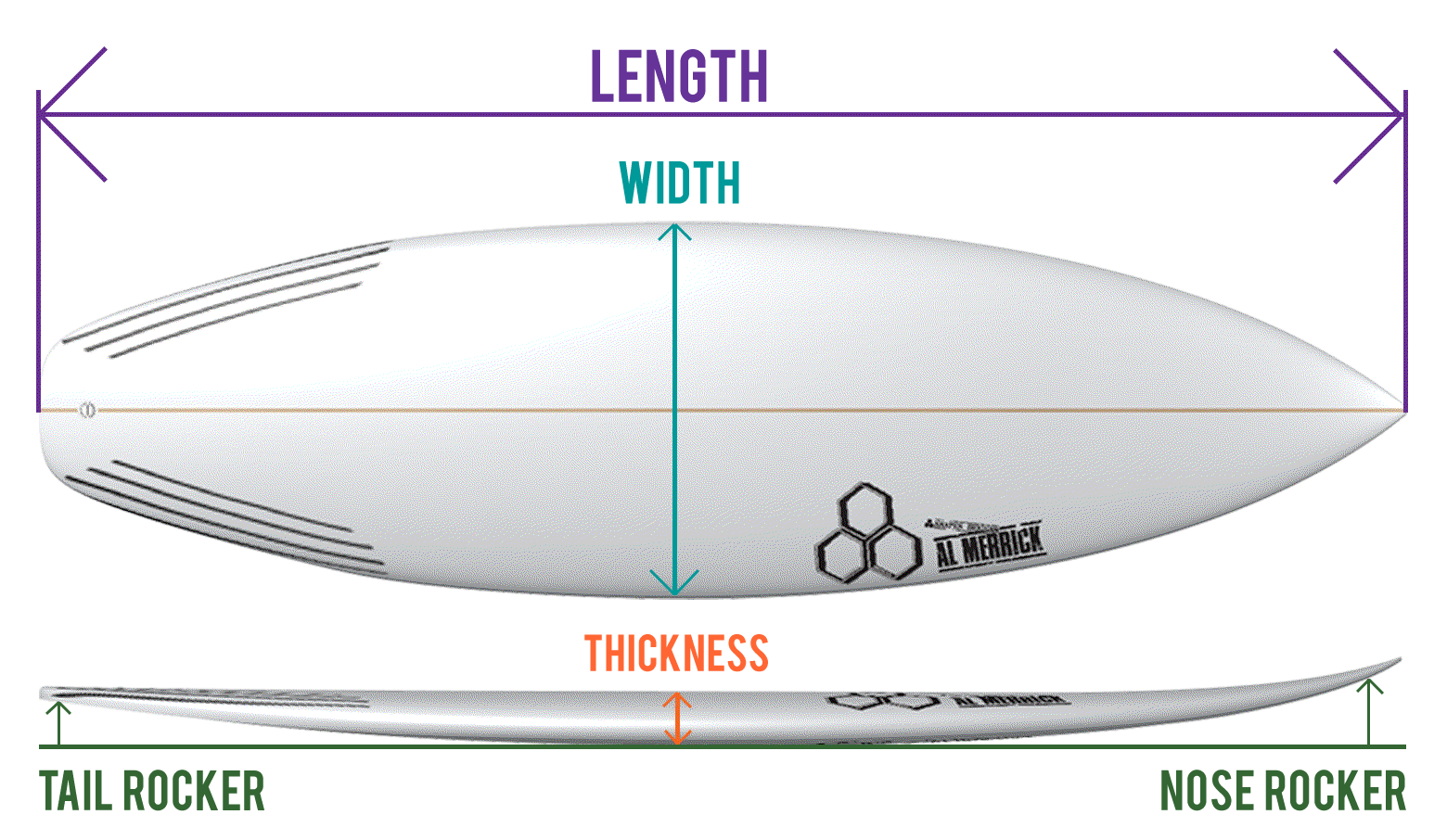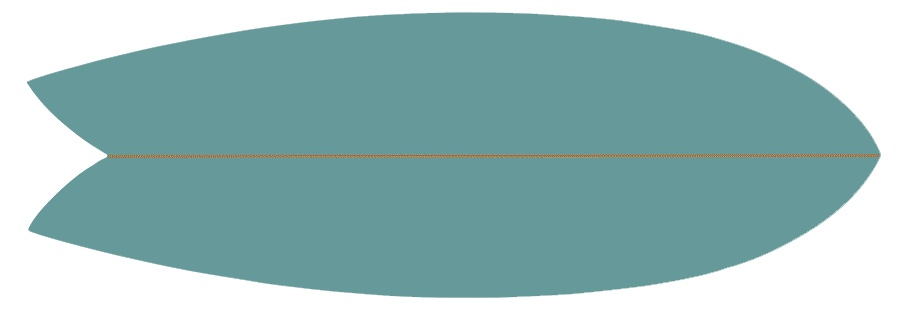Choosing a surfboard can be a long/confusing process… especially when you walk down into our boardroom and see over 500 boards!! Whether it's your first surfboard, or your 20th, this surfboard buyers guide is intended to ease the process by providing basic rules to follow and descriptions of many key components that go into building a surfboard. This guide should give you all of the information you need to pull the trigger on your next surfboard!
KEY TERMS
When your looking for your next surfboard, your going to hear or see a bunch of terms related to the way that the board feels and performs in the water. It's a good idea to be well versed before you make a decision, and the list below is all of the most important components to consider!
LENGTH refers to the measurement from the tip of the nose to the tail of the surfboard. Generally, the longer the board the more stable and easier it is to paddle.
WIDTH refers to the measurement of the width of the board at the widest point. Increasing the width of a surfboard can make the board more stable and forgiving without having to increase the length. Increasing the width of a board helps with paddle power and float, but can decrease maneuverability. Narrower boards track well in steep or hollow waves, as well as increase maneuverability.
THICKNESS refers to the measurement at the thickest point of the surfboard. Thickness varies a great deal throughout a surfboard, which is often referred to as foil. Thickness and foil can affect surfboards dramatically, such as keeping high volume in shorter lengths, or decreasing volume in longer lengths.

VOLUME refers to amount of buoyancy/float surfboard will have, given in cubic liters. This is calculated by the surfboard manufacturer by not only using length, width, and thickness, but also the template or overall shape of the surfboard. Generally, the higher the volume number the more float the surfboard will have. When shopping for a shortboard, it is helpful to know what the right volume is for you. Using a volume calculator can be helpful in finding your ideal volume, taking into account your height, weight, age, experience, and fitness levels. Check out this Volume Calculator provided by Lost Surfboards.
NOSE refers to the upper 12 inches of a surfboard. The shape of the nose can alter the way the board rides and paddles. With less volume in the nose of a board(i.e. a pointed nose), the smoother it will drop into larger waves and the easier it will be to duck dive. With more volume in the nose, the easier it will be to paddle and glide into waves, as well as being more stable to allow for nose riding (in longboards).
STRINGER refers to the thin strip of wood that traditionally runs through the center of the surfboard. The wood is typically made out of balsa, basswood, or cedar, and the thickness increases the strength and rigidity of the board. Multiple stringers make for added stiffness.
TAIL refers to the bottom 12 inches of the surfboard. Nowadays there are many different types of surfboard tail designs. Different designs alter the way that the water interacts with your surfboard, changing the maneuverability, speed, and hold while surfing a wave. See the surfboard tail section of the guide below for in depth descriptions of the most common surfboard tail designs.
ROCKER refers to the bottom curve a surfboard from the nose to the tail. The main purpose of rocker is to fit the board in the curve of the wave face. The flatter the board, the more likely you are to nose dive when dropping into steeper waves, however the easier the board will be to paddle/plane over the water. Rocker also affects the turning ability of the board, with more rocker giving the board a tighter turn radius (especially with increased rocker through the tail). See top right image for visual.
RAILS refer to outer edges of the surfboard from nose to tail. Since the rail is the primary interface of contact with the wave, the way the water interacts with the rail will affect the way the board will hold in big surf or the ability for the board to do maneuvers. For more info on surfboard rails, see the section below.
CONTOURS refers to the concaves (or lack thereof) on the bottom of the surfboard. The bottom contours affect the way water flows across the bottom of the surfboard, controlling how fast/slow a surfboard goes and the ability to control and turn it. For more info on surfboard rails, see the section below.
Scope out our Glossary page for more terms relating to surfboards!

SURFBOARD SHAPES
Surfboards can be split up into several different categories dependent on the length and outline of the board. The four main categories of surfboards are shortboards, fishes, funboards (or mid-lengths), and longboards. These boards differ in both length and overall shape and also cater to different types of surfers, different skill levels, and different waves. Unfortunately surfing is not a one size fits all sport - and that's why you see more experienced surfers that have built a "quiver" or collection of multiple boards.

SHORTBOARD
5’4” to 7’0”
Shortboards are a performance-based board, typically characterized by the narrow nose and tail, combined with a nice curved outline. This allows for high maneuverability and tight/quick surfing in the face of the wave. Shortboards are typically ridden by intermediate to expert surfers, mainly in medium to large waves. These boards come in a variety of different construction types and fin configurations. Nowadays there are many wider overall shortboards that work a bit better in smaller and weaker waves. This style shortboard is called a "groveler" and usually feature a wider nose and tail coupled with added width and thickness. Since this style is beefed up in the mid section - you can usually ride them shorter than you would your typical high performance shortboard.

FISH
5’0” to 7’0”
Fish surfboards are a bit more user friendly than traditional shortboards. They are typically a bit thicker and wider, offering more float and paddle power, and help surfers maintain speed in small surf. Most fish surfboards offer a full nose with flatter rocker than a shortboard, as well as a swallow tail. This allows the board to paddle easy and generate extra speed in the waves, but in doing so it gives up the maneuverability of a shortboard. Though these boards are often thought of a small wave board - they also work pretty well when the surf gets big, although it takes a good knowledge of the board paired with skill to pull it off.

MID LENGTH / FUNBOARD
7’0” to 8’6”
Mid lengths and funboards are a hybrid between a longboard and a shortboard - offering the paddle power of a longboard with added maneuverability similar to a shortboard. Funboards are a great beginner board for kids/teens, or a transition board for the surfer who started on a longboard and is ready to make the step to a shorter/more maneuverable board, without making the big jump to a shortboard or fish. There are also some mid lengths that are tuned for more experienced surfers - and usually have a more refined/pulled in tail and a often times a wider nose.

LONGBOARD
8’6” to 10’0”
Longboards are the most user friendly surfboards. With lots of length, thickness, and width they offer more than enough float and stability for beginners to learn to rip on. They are also great all around boards for intermediate/expert surfers - offering a mellow style that allows surfers to “hang toes off the nose”. There are a few different styles of longboards - often referred to as nose riders, performance longboards, and all around. These longboards suit specific styles or surfing as well as certain wave types.
SURFBOARD TAILS
After seeing a few surfboards, you have probably realized that there is a wide range of different surfboard tail shapes to choose from. Different tail designs alter the way that the water interacts with your surfboard, changing the maneuverability, speed, and hold while surfing a wave. Although some people claim that there are only two tail designs - the square tail (wide) and the pin tail (narrow), and everything else is just a version of these - we will go into detail all of the most common tail designs and how they affect the way you surf.

PIN TAIL
The pin tail is designed for maximum hold and control on the wave. These tend to be the narrowest of all of the tail designs, reducing surface area in the tail, allowing you to sink the tail into the water giving the board significant hold. With this added hold/traction, you reduce maneuverability. For that reason, these tails are typically surfed in large/fast waves where control in high speeds is more important than maneuverability.
ROUND TAIL
The rounded tail is based off the pin tail, with added surface area and width through the tail. This gives the board a bit more lift in the rear and allows for a more maneuverable board, without sacrificing too much hold. For that reason these tail designs can be ridden in small to big surf, best suited for surfers who want to carve and do drawn out maneuvers. Also very common in funboard shapes, as it adds the maneuverability factor into longer shapes.
SQUARE TAIL
Square tails are one of the earliest surfboard tail designs, the basis of most tail designs you see today. The square tail is nice and wide, giving you added stability and float in the tail. The corners of a square tail allow you to pivot the board for turns. These are most common in longboard shapes, but are still seen in shortboards.
SQUASH TAIL
Squash tails are the most common type of tail found on shortboards today. Based off the classic square tail, it allows for more width, increasing the surface area in the tail giving the board more lift - making it easier to plane through the water and maintain speed. The square/edgy shape allows for quick release, making it more responsive and easier to turn.
SWALLOW TAIL
A swallow tail is a popular variation of both the square and pin tail, with more surface area like a square tail, and two points that give the hold and traction of a pin tail. The wider tail allows it to maintain speed in soft parts of the wave, making it ideal for small waves. The two ends allow the board to feel solid and engaged when holding a hard turn and moving fast.
MOON TAIL
A moon tail is a based off of the classic swallow, usually a bit more pulled in with an arc connecting the rails. This reduces area in the tail of the board for maneuverability and hold, also extending the rail line into a "pin like" tail along each rail. Great for maintaining your speed and stability down the line in steeper surf.
DIAMOND & ROCKET TAILS
Diamond and Rocket tails area blend of rounded pin and squash tails with the corners moved a bit forward to keep the overall area and shortening the rail line. These tails are usually pretty loose and offer a good amount of release off the top.
BAT TAIL
A bat tail performs very similar to the swallow tail, however with a point in the center adding extra stability. These tails work great with a quad set up as the area removed and little corners will add some bite and help give a board with out a center fin a little extra drive.
ALTERNATIVE TAIL DESIGNS
Recently there has been increasing popularity in creating different style tail shapes including asymmetrical tail designs. These experimental designs typically take the elements of two popular tail designs and combine them into a shape that will offer the rider a different feel on his or her front side and back side. You will usually not see boards come stock with these tail designs - and if you are interested in trying one you should talk it over with your local shaper.
SURFBOARD RAILS
Surfboard rail design is a critical element in the way that your surfboard behaves in different types of waves. Rails are typically thicker near the center of the board, and get thinner as they approach the nose and tail of the board. Although there are many opinions as to which rails are right for which conditions, there are generally two basic types of rail design: hard and soft.
SOFT RAILS are rounded with no real hard edge. This means the transition between the rail and the bottom of the board is a smooth arc. Soft rails are much more forgiving and user friendly, especially in smaller/weak waves due to the added volume on the rail.
HARD RAILS (or a down rail) is a bit more squared off than a soft rail, typically angling down towards the bottom of the board, and sometimes may even form a corner or edge on the bottom of the board. Since these rails have less volume, they offer more hold for performance in good surf.
There are many different variations of these two main types of rails, and each surfboard shaper has their own preference and specific rail shapes. Some common rail designs include Round rails, down rails, rolled rails, 50/50 rails, 60/40 rails, and 80/20 rails to name a few. We may get into these deigns in another blog post - as they are beyond the scope of this basic guide.

SURFBOARD CONSTRUCTION
Surfboards nowadays are made in a variety of different constructions - with a recent push to manufacture surfboards as green/eco friendly as possible. Although there are many different types of materials being used by a variety of shapers, in this surfboard buying guide we will discuss the two most common types of construction.
POLYURETHANE (PU)
This is the most traditional surfboard construction, dating back to 1950s (during the time when most surfboards were between 9 and 11 feet!). Consisting of a polyurethane core, fiberglass and polyester resin, this is one of the simplest ways to make a surfboard nowadays, and is used by most shapers. PU boards are a bit more affordable than most other alternative construction surfboards. They also sit a bit lower in the water due to their increased weight, helping to keep your rail under the water and engaged. The extra weight can also help in choppy or windy conditions.
EPOXY
Epoxy boards have been starting to catch on with most major shapers, becoming a standard option for many brands. Made up of an expanded polystyrene (EPS) core and epoxy resin, EPS boards are much lighter and more durable than the conventional polyurethane boards. For this reason they are very popular for surfers that like to take to the air. EPS boards tend to have a bit more buoyancy to them, making them float a bit higher in the water and therefore have more planing speed and responsiveness. For this reason they are a favorite for small waves.
EPS surfboards are also much more environmentally friendly than their PU/PE cousins. EPS foam can be made from recycled materials, and epoxy resin takes a lot less energy to produce. Some companies such as Entropy are able to use “bioresin”, which uses tree sap as the base of the epoxy resin, significantly cutting the carbon footprint of the resin. Sustainable surfboards are the future!
ALTERNATIVE TECHNOLOGY
There are many other types of surfboard construction techniques being used by different shapers, and although they look dramatically different, most are a spin off of PU/PE or EPS/Epoxy boards. With a recent push on environmentally friendly and sustainable surfboards, brands are seeking plant based/low VOC resins and other alternative materials such as paulownia wood or cork. These types of surfboards are commonly referred to as ecoboards.
To learn about the different types of fin configurations on a surfboard and how fins can affect the way your board rides, check out our Guide to Surfboard Fins!